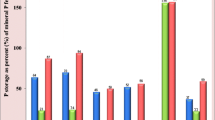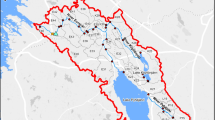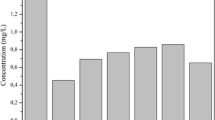Abstract
Material flow analysis (MFA) is a well-established tool for supporting decisions on nutrient management. This paper shows the importance of the system boundary chosen when an MFA system is established. To reach this goal, data of existing regional and global phosphorous studies was investigated in view of phosphorous-flows (P-flows) and stocks within and outside the systems observed. Then, internal flows and stocks to be managed are juxtaposed with upstream flows and stocks beyond the system boundaries. The results show that narrow system boundaries yield useful findings to improve regional P management on the short term. If, however, regional and global P-availability is to be secured for longer time periods, system boundaries must include the use and losses of P in the so-called ‘Hinterland’, defined as “the total amount of P used and lost abroad for the production of all goods imported into a country”. In some cases, these Hinterland flows appear to be dominant, jeopardizing measures to manage P in a cost effective, resource conserving, and environmentally sound regional way. Hence, the choice of system boundaries is crucial for MFA research. In particular, the huge losses of P in the global agriculture, as well as the magnitude of mining wastes must be considered for effective decisions regarding P management. Taking the Hinterland into account by linking global and regional P flows and stocks is mandatory if priorities for P management are defined.




Similar content being viewed by others
References
Somlyody L, Brunner PH, Kroiss H (1999) Nutrient balances for Danube countries: a strategic analysis. Water Sci Tech 40(10):9–16.
Seyhan D, Weikard HP, van Ierland E (2012) An economic model of long term phosphorus extraction and recycling. Resour Conserv Recycl 61:103–108.
Weikard HP, Seyhan D (2009) Distribution of phosphorus resources between rich and poor countries: the effect of recycling. Ecol Econ 68(6):1749–1755
Seyhan D (2009) Country-scale phosphorus balancing as a base for resources conservation. Resour Conserv Recycl 53 (12): 698–709.
Seyhan D (2006) Development of a method for the regional management and long-term use of non-renewable resources: the case for the essential resource phosphorus. Dissertation, TU Wien
Matsubae K, Kajiyama J, Hiraki T, Nagasaka T (2011) Virtual phosphorus ore requirement of Japanese economy. Chemosphere 84(6):767–772
Metson GS, Bennett EM, Elser JJ (2012) The role of diet in phosphorus demand. Environ Res Lett 7(4):044043
MacDonald GK, Bennett EM, Carpenter SR (2012) Embodied phosphorus and the global connections of United States agriculture. Environ Res Lett 7(4):044024
Baccini P, Brunner PH (2012) Metabolism of the anthroposphere, analysis, evaluation, design. 2nd edn, MIT Press, Cambridge.
Hertwich EG, Glen PP (2009) Carbon footprint of nations: a global, trade-linked analysis. Environ Sci Technol 43(16): 6414–6420.
Chen M, Graedel TE (2016) A half-century of global phosphorus flows, stocks, production, consumption, recycling, and environmental impacts. Glob Environ Change 36: 139–152.
Sheldrick WF, Syers JK, Lingard J (2002) A conceptual model for conducting nutrient audits at national, regional, and global scales. Nutr Cycling Agroecosyst 62(1):61–72
Cencic O (2012) Software platform STAN (short for subSTance flow ANalysis). http://www.stan2web.net. Access date 11 Jan 2017.
Eraslan F, İnal A, Güneş A, Erdal İ, Coskan, A (2009) Türkiye’de Kimyasal Gübre Üretim ve Tüketim Durumu, Sorunlar, Çözüm Önerileri ve Yenilikler. Süleyman Demirel Üniversitesi, Ziraat Fakültesi, Toprak Bilimi ve Bitki Besleme Bölümü, Isparta.
Seyhan D, Canli G, Akduman I, Yilmaz T (2015) Heating stove to effectively burn manure, with recycling. Pending patent TR 2015/11113.
Pham HG, Harada H, Fujii S, Nguyen PHL, Huynh TH (2016) Transition of human and livestock waste management in rural Hanoi: a material flow analysis of nitrogen and phosphorus during 1980–2010. J Mater Cycles Waste Manag 1:1–13
Yamasue E, Matsubae K, Ishihara K (2015) Weight of land use for phosphorus fertilizer production in japan in terms of total material requirement. Glob Environ Res 19(1):17
Morita K, Guo M, Oka N, Sano N (2002) Resurrection of the iron and phosphorus resource in steel-making slag. J Mater Cycles Waste Manag 4(2):93–101
Lee Y, Oa SW (2016) Resource-recovery processes from animal waste as best available technology. J Mater Cycles Waste Manag 18(2):201–207
Wang F, Sims JT, Ma L, Ma W, Dou Z, Zhang F (2011) The phosphorus footprint of China’s food chain: implications for food security, natural resource management, and environmental quality. J Environ Qual 40(4):1081–1089
Ma L, Wang F, Zhang W, Ma W, Velthof G, Qin W, Oenema O, Zhang F (2013) Environmental assessment of management options for nutrient flows in the food chain in China. Environ Sci Technol 47(13):7260–7268
Withers PJA, Sylvester-Bradley R, Jones DL, Healey JR, Talboys PJ (2014) Feed the crop not the soil: rethinking phosphorus management in the food chain. Environ Sci Technol 48(12):6523–6530
Ortas I (2012) The effect of mycorrhizal fungal inoculation on plant yield, nutrient uptake and inoculation effectiveness under long-term field conditions. Field crops research 125:35–48
Yamashiro T, Lateef SA, Ying C, Beneragama N, Lukic M, Masahiro I, Ihara I, Nishida T, Umetsu K (2013) Anaerobic co-digestion of dairy cow manure and high concentrated food processing waste. J Mater Cycles Waste Manage 15(4):539–547
Kahiluoto H, Kuisma M, Ketoja E, Salo T, Heikkinen J (2015) Phosphorus in manure and sewage sludge more recyclable than in soluble inorganic fertilizer. Environ Sci Technol 49(4):2115–2122.
Seyhan D, Erdincler A (2003) Effect of lime stabilization of enhanced biological phosphorus removal sludges on the phosphorus availability to plants. Water Sci Technol 48 (1): 155–162.
Acknowledgements
The authors are grateful to OeAD (Austrian Agency for International Mobility and Cooperation in Education and Research) for funding this research.
Author information
Authors and Affiliations
Corresponding author
Rights and permissions
About this article
Cite this article
Seyhan, D., Brunner, P.H. The choice of system boundaries for effective long-term management of phosphorus. J Mater Cycles Waste Manag 20, 345–352 (2018). https://doi.org/10.1007/s10163-017-0589-1
Received:
Accepted:
Published:
Issue Date:
DOI: https://doi.org/10.1007/s10163-017-0589-1




